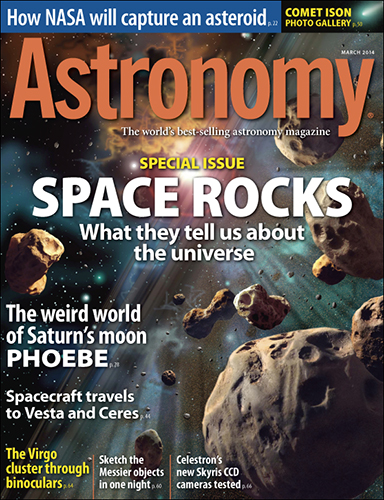
Key Takeaways:
WAUKESHA, Wis. – Since a tiny asteroid exploded over Russia last February, space rocks have been enjoying lots of time in the public spotlight. From the reactivation of a NASA satellite specifically to hunt near-Earth objects to plans to study one up close with human hands, various missions in the past year have had a singular focus: to learn more about these relics of the early solar system and possibly prevent a catastrophic impact with one in the future.
But scientists have been interested in asteroids for years, and in March’s special issue, the magazine focuses on both current and future efforts to better understand them, starting with the craziest. In “Skyjacked! NASA’s audacious plan to tow an asteroid to Earth,” author Ray Villard details a future asteroid capture mission that would involve lassoing a small near-Earth object, moving it into lunar orbit, and launching astronauts to rendezvous it for up-close study. It might sound improbable, but the Obama administration has already requested $105 million in this year’s NASA budget to plan such a feat, with a desired launch date of 2017.
While the public waits to see how this future mission pans out, scientists are already enjoying great success studying space rocks robotically. In “Exploring the biggest asteroids,” Sarah Scoles provides the latest from NASA’s Dawn spacecraft, which is currently traveling between main-belt asteroids Vesta and Ceres. Dawn spent 14 months orbiting the slightly smaller Vesta, where it discovered evidence of hydrated materials and other planet-like characteristics. Now a year from rendezvousing with Ceres, the mission team hopes that this large asteroid/dwarf planet might tell us why Earth is different from the moons of the outer planets and possibly how water ended up on our planet.
And speaking of outer-planet moons, the March issue also explores one such object that might also share double duty as a captured asteroid. In “The weird world of Phoebe,” Michael Carroll explains why scientists believe this Saturn moon didn’t form with its satellite siblings and what makes it such an oddball world. “With its cone-shaped craters, rich mineralogy, spherical shape, high density, and perhaps great age, Phoebe seems more planet than moon,” Carroll writes. “And yet this bizarre little world ranks small in the solar system’s retinue of satellites.” How could this be?
Pick up the March issue of Astronomy, on newsstands February 4, to learn more about these small but important objects in our solar system and scientists’ plans to study them.
March marathon challenges
March is Messier marathon month, when observers frequently challenge themselves to view all 109 deep-sky objects in Charles Messier’s catalog in a single night. It’s an outstanding feat, but if you’re looking to push yourself even a little bit further, this issue has two articles for you. In “Sketch the Messier objects in one night,” Astronomy columnist Erika Rix suggests not only observing but also sketching all 109 targets. She attempted such a task last March, and in the article Rix shares her troubles and success as well as provides tips for others who are up to the challenge.
If instead you say, “Been there; done that,” to any kind of Messier marathon, why not try Tom Polakis’ challenge instead: “Run a globular cluster marathon.” He created a 109-member list of such starry conglomerations visible in March and attempted to view them all as others took on the Messier marathon. See which objects he chose, how the night played out, and how successful he was before trying this task yourself.
March sky events visible without optical aid
- March 10 – The Moon passes within a few degrees of Jupiter.
- March 14 – Mercury reaches its peak in the early morning hours.
- March 22 – Venus reaches its 2014 morning peak.
- March 30 – Mars visits Spica, Virgo’s brightest star.
Also in the March 2014 Astronomy
- “Comet ISON’s final hurrah” – Although the visitor from the distant Oort Cloud did not survive its late-November brush with the Sun, it provided observers with a memorable show in the weeks before.
- “How I made my dream observatory” – The way this observer housed his telescope may give you some tips you can apply to your own project.
- “Explore the Virgo cluster through binoculars” – Set a goal this spring: 14 galaxies in 2014.
- “Image the solar system with Celestron’s Skyris” – Good sensitivity, high-quality construction, and a lightweight package make these CCD cameras must-have planetary imagers
- “The Sky this Month” – Exclusive star charts will guide you through March’s night sky.
- The December issue of Astronomy also includes Astro News, Ask Astro, Snapshot, Breakthrough, Bob Berman’s Strange Universe, Stephen James O’Meara’s Secret Sky, Glenn Chaple’s Observing Basics, Adam Block’s Cosmic Imaging, Erika Rix’s Astro Sketching, Cosmic World, Letters, Web Talk, New Products, Reader Gallery, and Final Frontier.









